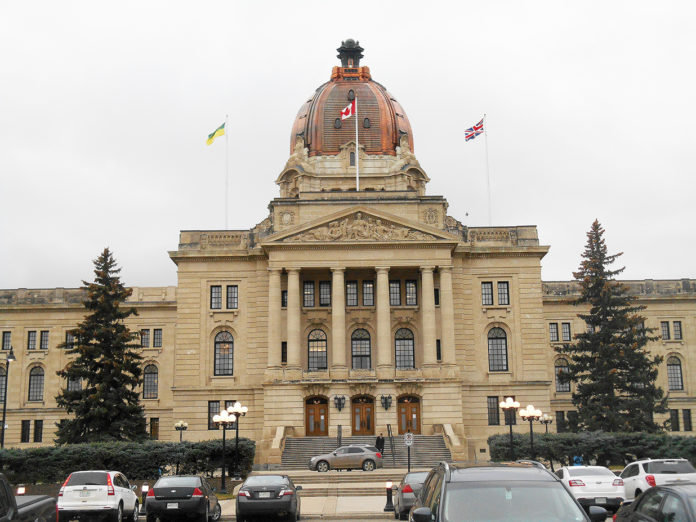Province officially out of recession as GDP grows for first time in three years
Thanks to higher-than-predicted non-renewable resource revenues and an extra $30 million in revenue from SaskPower, the Government of Saskatchewan’s first quarter financial report is forecasting a deficit of $306 million, a decrease of $59 million from the budget.
According to the report, released Monday, revenue is forecast to be up $172 million. However, that increase is offset by higher pension expenses and increased health and social services spending, along with a $17 million increase in the province’s wildfire fighting budget.
As of this financial update, the forecasted WTI price of oil per barrel is almost $10 higher than budgeted. The well-head price, which captures what Saskatchewan producers get for extracted light, medium and heavy oil, is $8.47 higher than budgeted.
A similar scenario is playing out in the potash industry, where Netback US KCI is up $10 per tonne, and Canadian K2) is up $21 per tonne.
Overall, oil production is down a little bit, and potash sales are up. The Canadian dollar forecast hasn’t changed.
Those factors lead to a $135.5 million increase in projected non-renewable resource revenue as compared to what was included in the 2018-19 budget.
The other positive pressure on Saskatchewan’s budget comes from an increase in Crown Corporation income.
That increase amounts to a projected $36.2 million, once losses from SGI and the auto fund due to higher summer storm claims are taken into account.
SaskPower is seeing a projected $30.6 million increase in income thanks to both sales to large customers and increased exports and trading with Alberta. There’s also a $27.9 million consolidation adjustment on the books to reflect an adjustment made in 2017-18 public accounts.
Other Crown corporations, though, such as SaskEnergy and SLGA, have seen their projected income dip by about $2 million each. The SaskEnergy reduction is a result of unrealized market value adjustments, while SLGA is seeing lower video lottery terminal revenue.
On the expense side of the equation, the largest increase is under education, as the pension expense for the teachers’ superannuation plan is forecast to increase by $55.3 million. That’s due to changes in interest rates and assumptions.
Both health and social services are forecasting an increase in their expenses by $20 million over the budget due to increased use of the services. The health ministry expenses are from “utilization pressures” across the health system, while social services attributes its increase to increased caseloads in Child and Family Services.
Expenses for the Ministry of the Environment and Natural Resources is projecting a $17 million expense increase from forest fire operations attributed to this year’s wildfire activity.
Public debt is projected to decrease, both because of the increase in pension payouts and due to lower debt amongst Crown corporations.
Economy grows for first time in three years
Monday’s report also included a look at some of the province’s economic indicators. While the province is showing growth amongst several indicators, it remains at the bottom of the Canada-wide rankings for many of the same categories.
Some of that could be influenced by population. Despite a one per cent growth in population year-over-year, Saskatchewan remains the seventh most populous out of Canada’s ten provinces.
Real GDP by industry grew in 2017, meaning, by definition, the province is no longer in a recession. The prior two years, GDP growth had been negative. The average forecast GDP growth among private sector agencies is 1.8 per cent. That’s 0.5 per cent above the GDP growth included in the 2018-19 budget.
Manufacturing sales are up 11.1 per cent, the second highest growth among the provinces, and international exports are up four per cent.
Wholesale trade and new vehicle sales have also shown growth for the last three months. The province’s inflation is the highest in Ca
Still, Saskatchewan’s average weekly earnings, retail sales, wholesale trade, new vehicle sales, exports, building permits, housing starts and construction investment range from eight to tenth among Canadian provinces. Saskatchewan’s year-to-date inflation rate is the highest in Canda.
“Thus far, economic performance in 2018 is mixed, but remains on track,” the report said. It cited challenge s such as weak employment growth, the McArthur River Mine Site shutdown, the looming federal carbon tax, rising interest rates and greater global protectionism.
Three months into the fiscal year, we’re seeing a growing economy and an improving fiscal picture,” Finance Minister Donna Harpauer said in a press release accompanying the report.
“Our government continues to manage spending carefully, invest in priorities for Saskatchewan people, shift from our reliance on volatile resource revenue and help keep our economy strong. Our economy grew for the first time in two years last year and while it is early, we continue to see some positive signals this year. In terms of our fiscal plan, there is still work to do, but we are on course to return the province to balance by 2019-20.”


